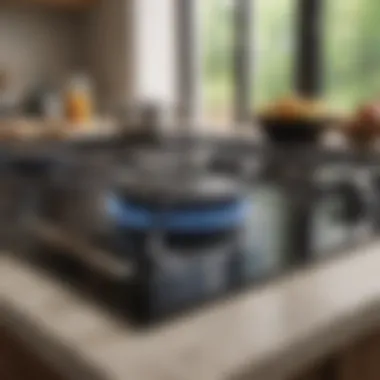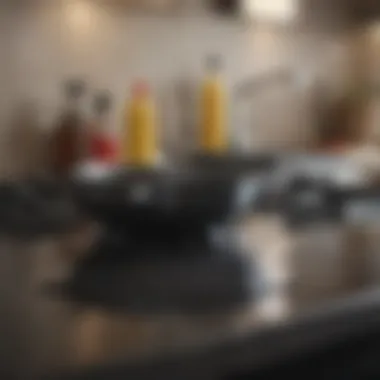Stove Top Surface Cleaner: Insights & Tips for Use


Intro
Stove tops are essential in any kitchen, serving as the primary workspace for cooking and meal preparation. However, keeping them clean is often a challenge. Various cleaners promise to restore a shine or remove greasy stains, but the effectiveness of these products can vary significantly. Understanding the different types of stove top surface cleaners available and how to use them properly is crucial.
In this article, we will explore the various options for stove top cleaners, detailing how each type works on different materials, from glass and stainless steel to ceramic and induction surfaces. Additionally, we will examine effective cleaning methods, maintenance tips, and the potential health implications of the ingredients in these cleaners. By the end, readers will be equipped with the knowledge necessary to choose the right product for their stove top, ensuring a clean and safe cooking environment.
Stove tops accumulate grime, spills, and stains over time. Therefore, it is essential to address these issues promptly. Selecting the right cleaner can make all the difference between an immaculate surface and a kitchen that appears neglected. With a focus on practical advice and insights, this article aims to guide kitchen enthusiasts in maintaining their cooking surfaces with confidence.
Understanding Stove Top Surfaces
Stove tops come in various materials, each with unique characteristics that affect cleaning methods and cleaner selection. Understanding these surfaces is key to maintaining their appearance and functionality. This section discusses the common types of stove top materials and the implications for cleaning.
Types of Stove Top Materials
Glass
Glass stove tops are known for their sleek and modern look. They offer a smooth surface that is easy to clean. One key characteristic is that they resist scratching, provided one uses suitable cleaning methods. They become a popular choice due to their aesthetic appeal in contemporary kitchens.
However, glass can stain if spills are left unattended. If residue dries on the surface, it becomes harder to remove. Therefore, regular maintenance is important for glass stove tops to ensure they remain shiny and clear.
Ceramic
Ceramic stove tops are notable for their heat distribution. Their polished surface makes them attractive and easy to clean. The beneficial aspect is their resistance to heat and stains, which contributes to longer-lasting performance.
Yet, ceramic can crack if a heavy pot is dropped. This risk requires careful handling. While they are visually appealing, one should be cautious with cleaning products, as some chemicals can wear down the finish.
Stainless Steel
Stainless steel stoves are robust and offer excellent durability. They are popular for their resistance to rust and corrosion. This material is also easy to sanitize, making it widely used in professional kitchens.
However, fingerprints and smudges can be a challenge. Regular cleaning is essential to maintain the appearance of stainless steel. Different types of cleaners, some of which can leave streaks, should be selected carefully.
Electric Coil
Electric coil stove tops provide reliable heating. Their key characteristic is the straightforward design, which is easy to maintain. Cleaning can be a simple task, often involving a mild detergent and a cloth.
Nonetheless, the coils can accumulate burnt food over time. This makes it necessary to clean them thoroughly after heavy cooking sessions to avoid unpleasant odors.
Induction
Induction stovetops are relatively new and have gained popularity due to their speed and efficiency. They heat directly through electromagnetic energy, making them energy-efficient. The unique feature of induction is that the surface itself stays cooler to the touch compared to other types, which reduces the risks of burns.
However, the specific cookware needed for induction can limit options. It is also crucial to use the right cleaners to avoid damage to the surface while maintaining its unique properties.
The Importance of Selecting the Right Cleaner
Choosing the correct cleaner is essential for maintaining the integrity and appearance of any stove top surface. Incorrect cleaners can lead to damage or ineffective cleaning, which can make the stove top less appealing and harder to maintain in the future. A thorough understanding of both the stove top material and attainable cleaners promotes proper cleaning habits, ultimately leading to better stove top maintenance.
Types of Stove Top Surface Cleaners
Understanding the various types of stove top surface cleaners is crucial for maintaining a clean and hygienic cooking environment. Each type of cleaner offers unique benefits and drawbacks, suited for different surface materials and types of stains. Selecting the right cleaner can result in more effective cleaning, less damage to surfaces, and improved safety during use. In this section, we will explore liquid, paste, spray, and natural cleaners, delving into their specific characteristics and best applications.
Liquid Cleaners
Liquid cleaners are versatile and often easy to use. They typically come in spray bottles for convenient application. Most liquid cleaners are designed to dissolve grease and breakdown food particles quickly. This makes them effective for daily use, especially in households where time-saving is a priority. However, it’s essential to choose a liquid cleaner that is compatible with the stove top material to avoid unintended damage.
Paste Cleaners


Paste cleaners offer a denser formulation that can tackle stubborn stains and baked-on residues. They are particularly effective on tougher materials like stainless steel or ceramic. One may find that paste cleaners require more elbow grease to apply, as they often need scrubbing to achieve optimal results. Their thicker consistency allows them to cling to vertical surfaces, making them useful in various cleaning scenarios.
Spray Cleaners
Spray cleaners are popular for their convenient application. They allow for an even distribution of product on the stove top surface. While some spray cleaners are aimed at specific surface types, others provide a general cleaning solution. One advantage of spray cleaners is their ability to reach difficult corners and crevices without requiring a lot of additional equipment. However, caution must be exercised to ensure that the cleaner does not contain harsh chemicals that could affect the health of users or the home environment.
Natural Cleaners
Natural cleaners have gained traction due to their eco-friendliness and safety in homes. Here, we explore three popular natural cleaning agents: baking soda, vinegar, and lemon juice.
Baking Soda
Baking soda is renowned for its excellent cleaning properties. It acts as a gentle abrasive that can scrub away tough stains without scratching surfaces. This makes it a beneficial choice for cleaning delicate glass or ceramic stove tops. Furthermore, baking soda can neutralize odors, adding another layer of utility to its effectiveness. Its major advantage is its non-toxic nature, which renders it safe for homes with children and pets. However, it may require more effort for severe grime compared to commercial cleaners.
Vinegar
Vinegar is another natural cleaner celebrated for its ability to cut through grease and eliminate mineral deposits. The acidity of vinegar helps to restore shine to surfaces and acts as a disinfectant. It is also very affordable and widely available, making it an accessible option for many homes. While effective, vinegar's strong scent can be off-putting to some users, and it should be avoided on natural stone surfaces as it may cause etching.
Lemon Juice
Lemon juice provides a fresh scent along with its cleaning capabilities. It has natural antibacterial properties and can effectively break down grease. The acidity in lemon juice allows it to lift stains and provide a brightening effect to surfaces, making it a natural choice for light cleaning tasks. However, similar to vinegar, lemon juice should not be used on sensitive surfaces as it can cause damage over time. Its appeal lies in its pleasant aroma and natural composition, resonating with those seeking a holistic approach to cleanliness.
"Selecting the right type of cleaner is essential for both efficiency and safety when tackling stove top stains and residues."
In the next sections, we will further explore how to select the right cleaner based on specific cleaning needs and the stove top material.
Selecting the Right Cleaner for Your Needs
Choosing the correct stove top cleaner is crucial to maintaining both the appearance and functionality of your cooking surfaces. The market offers various cleaners tailored for specific materials and types of stains. Understanding your stove top surface and the residue present can help you make a more informed selection. This not only leads to better cleaning results but also extends the life of your stove. Using a cleaner not suited for your specific material can cause scratches, discoloration, or even damage over time.
Identifying Stains and Residue Types
Proper identification of stains is key to selecting the right cleaner. Different types of stains require different approaches and cleaners. Here, we will explore the most common types of stains you might encounter on your stove top.
Baked-On Grease
Baked-on grease is often the result of cooking oils that have splattered and solidified over time. This type of stain is stubborn and requires a strong cleaning agent for effective removal. A notable characteristic of baked-on grease is its resilience; it can bond to the surface material, making it a significant concern for kitchen cleanliness. This residue necessitates a powerful cleaner that can penetrate and dissolve it, otherwise, surface scrubbing can damage the finish.
While some people might find natural solutions helpful, many prefer commercial products that specifically target this type of stain because they provide immediate results.
Water Stains
Water stains appear mostly after moisture evaporates, leaving mineral deposits behind. They can be less challenging to remove compared to baked-on grease but still require attention. The key characteristic of water stains is that they are usually not as deeply embedded as greasy residues.
For this type of stain, soft cloths with mild cleaners generally do the trick well. However, not addressing these stains promptly can lead to persistent deposits over time, which become harder to remove.
Food Spills
Food spills occur frequently and can vary from sauces to crumbs, which can lead to unsightly marks if not dealt with right away. The distinguishing feature of food spills is their variety in composition, making them somewhat unpredictable in cleaning needs. Some spills might require a degreaser, while others can be cleaned up with basic soap and water.
Diligently managing food spills can prevent them from becoming baked-on stains, thus making them easier to clean. For this reason, having the right cleaning approach for different types of spills is advantageous for optimal stove maintenance.
Compatibility with Surface Material
It is essential to ensure that the cleaner selected is compatible with the stove top material. Glass, ceramic, stainless steel, and induction surfaces have different sensitivities and requirements. Using a cleaner not suited for a specific surface can lead to lasting damage.
Stainless steel, for instance, often needs cleaners that do not contain harsh chemicals or abrasive components to avoid scratches. On the other hand, induction cooktops require gentle care, as strong agents can mar their non-stick surface. Identifying the type of material your stove top is made of is the first step towards not only selecting the right cleaner but ensuring longevity and preservation of the surface.


Application Techniques for Cleaners
When it comes to effectively maintaining a stove top surface, the application techniques for cleaners play a crucial role. Without proper methods in cleaning, even the best products can yield unsatisfactory results. Application techniques not only help in the efficient removal of stains and residues but also in ensuring the safety of both the surface and the user. Knowing how to accurately apply, rinse, and dry the cleaner can make a significant difference in the outcome of the cleaning process.
Preparing the Surface
Before applying any cleaner, preparing the surface is key. This involves removing loose debris and food particles from the stove top. Having a clean base helps prevent additional scratches and ensures the cleaning agent can work more effectively. Use a dry cloth or a soft brush for this step. It's important not to skip it. If the surface is warm, wait until it cools down, as some cleaners are not effective on hot surfaces.
This preparation phase can greatly impact the final cleanliness of the stove. By addressing visible residues first, you can avoid unnecessary scrubbing and make the process smoother.
Step-by-step Cleaning Process
Applying the Cleaner
This step is critical. When applying the cleaner, even distribution is crucial. Focus on small areas instead of applying a large amount at once. This allows for better control and helps ensure that all particles can be reached. Many products come with a spray nozzle, which makes application simpler and cleaner. This characteristic of applying in a controlled manner minimizes overspray and waste, making it a popular choice among users.
However, one must be cautious with the amount used. Overusing cleaner can lead to product buildup and is counterproductive. Applying just enough allows for effective cleaning without any residue left behind afterward.
Soaking Time
Soaking time is a vital aspect that should not be underestimated. After applying the cleaner, giving it adequate time to sit can maximize its effectiveness. The main advantage of soaking is that it allows the active ingredients to break down tough stains and baked-on grease. Longer soaking times might be necessary for more stubborn residues, while lighter stains may need little time.
A disadvantage can arise from excessive soaking, leading to potential damage on sensitive surfaces if not washed away correctly. Always refer to the cleaner’s instructions regarding recommended soaking durations. This systematic approach can give predictable and reliable results.
Scrubbing Techniques
Following soaking, scrubbing is the next step. The technique used is important to protect the stove top’s finish. Soft sponges or cloths are generally recommended to avoid scratching delicate surfaces. A circular motion is effective in lifting residue without forcing the material against the surface. The key characteristic of scrubbing is maintaining a gentle yet thorough technique that yields the best results with minimal effort.
While using more abrasive materials can seem tempting for tough stains, the risk of damaging the surface often outweighs the short-term benefits. It’s essential to choose your tools wisely based on the stove top material to prevent unwanted damage.
Rinsing and Drying
Rinsing is the final touch needed to complete the cleaning process. Thoroughly remove all remnants of the cleaning solution to avoid leaving any residue behind. This step ensures that no chemicals remain that could interfere with cooking.
Drying should follow rinsing. Using a clean, dry cloth will not only help to dry the surface quickly but also provide a final polish. This last action enhances the appearance of the stove top, making it safer and aesthetically pleasing. Omitting this step may lead to water spots or streaks, which can detract from the cleanliness achieved.
Overall, these application techniques contribute significantly to a successful stove top cleaning routine. Taking time to understand each step allows for the development of informed habits, ultimately leading to a cleaner, more efficient cooking surface.
Health and Safety Considerations
Understanding health and safety considerations when using stove top surface cleaners is essential. Many cleaners contain chemicals that can be harmful if not handled properly. Awareness of these elements equips users to make safer choices, reducing potential health risks while cleaning their cooking surfaces.
Ingredients to Avoid
Certain ingredients in stove top cleaners should be avoided to minimize health risks. Here are some common hazardous substances:
- Ammonia: This can generate toxic fumes, especially when mixed with other cleaners. It can irritate the eyes and respiratory system.
- Bleach: While effective for sanitization, bleach poses a significant risk if inhaled or if it comes in contact with skin. It should never be mixed with ammonia, as this can create dangerous gases.
- Parabens: Often used as preservatives, parabens may have potential endocrine-disrupting effects. While common in many products, they are best avoided for safer alternatives.
- Phosphates: Found in some cleaners, they can contribute to water pollution. Choosing phosphate-free products aids in environmental conservation.
Always scrutinize the label to ensure you avoid harmful components in cleaner products.
Safe Handling Practices
Using stove top surface cleaners safely involves a few straightforward practices:
- Read Instructions: Begin with the product’s label and instructions. Adhering to guidelines ensures proper application and minimizes risk.
- Use Gloves: Wearing protective gloves can prevent skin irritation and allergic reactions. This is especially important when handling stronger cleaners.
- Ensure Ventilation: Work in a well-ventilated area. Open windows or turn on an exhaust fan to dissipate fumes while cleaning.
- Store Safely: After use, store cleaners in a secure location, out of reach of children. Keep them in their original containers to prevent confusion.
- Dispose Properly: Follow guidelines for disposing of used products. Some cleaners may require special disposal methods to prevent environmental harm.
Implementing these practices not only safeguards personal health but also contributes to a safer household environment.


Maintaining a Clean Stove Top
Keeping a stove top clean is essential not just for aesthetics but also for functionality and safety. Regular maintenance prevents the build-up of grease and cooking residues that can affect the performance of your stove. A clean stove top also reduces the risk of cross-contamination and ensures that food prepared is safe and healthy. Investing time in maintaining your stove can prolong its lifespan and save on costly repairs or replacements in the future.
Regular Cleaning Routines
Establishing a consistent cleaning routine is the foundation of effective stove top maintenance. This routine should ideally occur after every cooking session, especially if spills or splatters have occured. Here are some key points to consider:
- Immediate Clean-Up: Wipe down the stove top shortly after cooking. This prevents stains from setting in.
- Use Appropriate Cleaners: Choose cleaners that are suitable for your stove top material. For example, glass stove tops require different care than ceramic or stainless steel ones.
- Spot Check: Look for any residue or marks regularly. Take care of these spots before they become a bigger issue.
Incorporating these simple steps into your daily routine can make a significant difference in the overall cleanliness of your stove top.
Preventative Maintenance Tips
Preventative maintenance plays a critical role in reducing the frequency of deep cleaning needed for your stove top. Here are some practical tips to help keep your stove top in good condition:
- Use Protective Liners: For gas stoves, consider using burner covers that can catch spills before they reach the surface.
- Avoid Heavy Scrubbing: Use non-abrasive pads to clean your stove top surfaces. Heavy scrubbing can scratch and damage the materials over time.
- Regular Inspections: Check the stove top for any damages or wear and tear. Address any issues promptly to prevent worsening of the condition.
Keeping these preventive measures in mind ensures not only a clean and safe cooking environment but also enhances the longevity of your stove.
Environmental Considerations
The growing awareness of environmental issues influences many areas of everyday life, including cleaning practices in our homes. When it comes to stove top surface cleaners, understanding environmental considerations is crucial. Using eco-friendly options contributes not only to a healthier living environment but also to the well-being of the planet. Many traditional cleaners contain harsh chemicals that can have detrimental effects on ecosystems and air quality. Therefore, opting for more sustainable cleaning options becomes not just a preference but a responsibility.
By selecting products that are biodegradable, non-toxic, or made from natural ingredients, individuals can minimize the negative impacts associated with chemical cleaners. This conscious choice supports a long-term vision of sustainability, ensuring that harmful residues do not enter the water supply or affect wildlife. Furthermore, using less harmful materials can result in fewer health risks for users, making it a better choice for everyone in the household.
Eco-Friendly Cleaning Options
Eco-friendly cleaning options come in a variety of forms, targeting the specific cleaning needs for stove tops. Here are a few notable examples:
- Vinegar: An effective natural cleaning agent that cuts through grease and grime. Its acidity helps in breaking down tough stains without harming the surface.
- Baking soda: Often used as a gentle abrasive, it can help remove stubborn stains while being safe for various stove top materials.
- Lemon juice: This not only offers a fresh scent but also helps in eliminating stains due to its natural bleaching properties.
These options are not just better for the environment but can also be cost-effective and readily available in most kitchens. Implementing these alternatives can significantly reduce reliance on commercial cleaners filled with chemicals.
Reducing Chemical Usage in Home Cleaning
Reducing chemical usage in home cleaning requires a thoughtful approach. To start, identify specific areas where traditional cleaners are used. Here are some practical steps to consider:
- Assess Cleaning Needs: Evaluate what types of stains or messes are common on your stove top. This can help in selecting suitable green alternatives that effectively address those issues.
- Dilute Cleaners: If using store-bought eco-friendly cleaners, consider diluting them with water. This can be especially useful for light cleaning tasks, reducing overall chemical usage while maintaining effectiveness.
- Use Multi-Purpose Cleaners: Instead of having multiple cleaners for different surfaces, opting for a single, eco-friendly multi-purpose cleaner can significantly cut down on the range of chemicals used.
- Educate Yourself: Learning about the ingredients in cleaners and their environmental impact can guide better choices. Being informed helps in navigating product labels and making smarter purchases.
By implementing these strategies, you not only reduce the chemicals used in your kitchen but also contribute to a healthier living space and a more sustainable lifestyle.
End
The conclusion of this article sheds light on the integral role that stove top surface cleaners play in maintaining not only the appearance of kitchen surfaces but also hygiene and safety in cooking environments. By comprehensively exploring the various types of cleaners available, as well as the appropriate application methods, this piece serves as a valuable guide for anyone looking to preserve their stove top.
Choosing the right cleaner and applying it correctly can lead to a more enjoyable cooking experience. Clean stove tops can prevent food contamination and reduce the risks associated with residual grease and burnt-on food. Therefore, understanding the cleaners available and the right techniques for application is crucial. Not only does this promote a cleaner kitchen, but it also extends the lifespan of stove tops.
Summary of Key Points
Throughout this article, several key points emerge:
- Types of Stove Top Surfaces: Different materials require specific cleaning approaches, affecting what cleaners to use.
- Variety of Cleaners: Options like liquid, paste, and natural cleaners cater to diverse cleaning needs based on stains and surface type.
- Application Techniques: A systematic cleaning process, including soaking, scrubbing, and rinsing, maximizes effectiveness.
- Health Considerations: Awareness of harmful ingredients in certain cleaners is vital for safe home environments.
- Environmental Impact: Eco-friendly cleaners and practices can minimize harmful chemical use, supporting sustainability.
Encouragement toward Informed Choices
In the end, this article encourages readers to make informed choices regarding stove top surface cleaners. It is essential to consider not just effectiveness but also safety and environmental impact. By selecting cleaners that align with their specific stove top material and personal health values, users can ensure their cleaning routines contribute to a hygienic cooking space.
Understanding the broader implications of cleaning products on health and environment motivates consumers to seek out options that are both effective and responsible. When buying a stove top cleaner, think critically about which product best supports not just a clean surface, but a healthier home.
"An informed choice leads to a safer, cleaner, and more enjoyable cooking experience for everyone."
This guide imparts the necessary insights for maintaining a pristine stove top, ultimately elevating one's culinary ventures.















